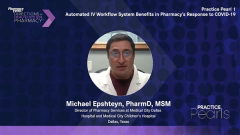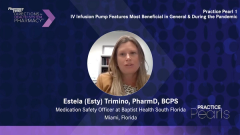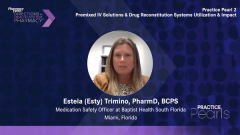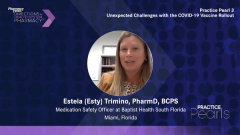
Practice Pearl 2: Benefits and Challenges of In-House Compounding of IV Products
Michael Epshteyn, PharmD, MSM, shares benefits and challenges of in-house compounding of IV products at his organization and the technologies involved.
Episodes in this series

Madeline Camejo, PharmD, MS: Focusing on IV [intravenous] medications, let’s discuss IV infection control. One of the questions that I have for you, Michael, is what in-house compounding of IV products is done within your organization and what types of technologies are used in those processes? And what are some of the benefits and challenges you have with in-house compounding?
Michael Epshteyn, PharmD, MSM:That’s a great question. With all the new regulatory requirements of USP-797 and USP-800 [United States Pharmacopeial Convention guidelines], all the health care systems are looking at optimizing what needs to be compounded in an IV room versus what can be taken outside of the IV room to reduce potential for contamination and to improve shelf life and beyond-use dating. We were fortunate enough to finish our complete renovation of our sterile compounding room right before COVID-19 started. We felt that that was lucky for us because once the COVID-19 pandemic came into play, that was the main focus, and everything else was placed on hold. We were lucky to completely renovate our IV room. We have 6 hoods that are dedicated to compounding, and we use IV room workflow technology, where there is a computer by each sterile compounding station where images are taken and we can optimize beyond-use dating based on the information that’s entered in the IV room workflow database.
Having said that, we’ve also tried to do some of the things that have been mentioned here by my colleagues, like optimizing IV push technology for delivery of medication, where no bags or tubing are utilized. And actually, IV push would also free up the need to even have a pump. That is one of the innovative ways that all of us have been looking at and reviewing over the last 5 years, but with the pandemic we readdressed and optimized how many different types of medications can be given through IV push. We’ve also tried to implement any ready-to-use technologies. Ready-to-use IVs would be great to have because those can be loaded into automated dispensing machines and be ready at the point of care.
Then finally, we’ve tried to optimize all kinds of connector devices available to us also for immediate use. To explain to the listeners, the connector device assists in attaching the fluid to the medication vial. Therefore, we would not have the need to mix it ahead of time, and the drug could be mixed right prior to administration. We utilized all of those strategies to reduce potential for cross contamination and to make drugs available for immediate use at the point of care, and also hopefully, to reduce waste. The idea here is if you don’t premix things way ahead of time, as the plan of care changes, you can adjust in time and don’t have to remake drugs, especially since our resources in terms of medications are limited, and also, of course, we want to make sure we use our human resources effectively as well.
Transcript edited for clarity.
Newsletter
Stay informed on drug updates, treatment guidelines, and pharmacy practice trends—subscribe to Pharmacy Times for weekly clinical insights.























































































































































































































